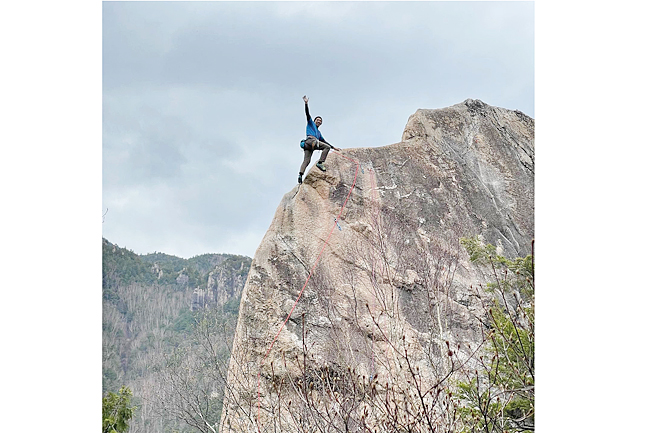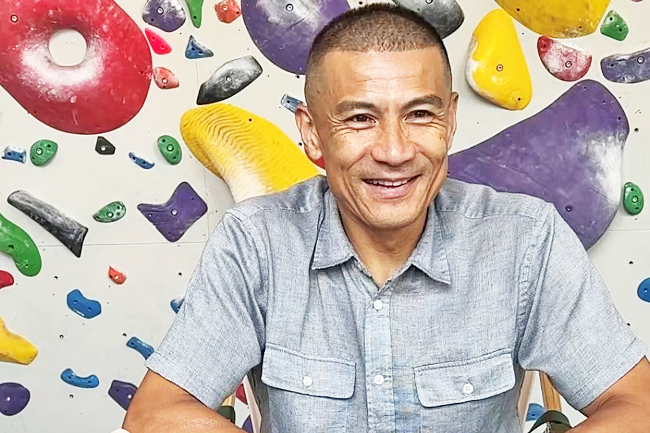CNA – If you’re into climbing and bouldering, and religiously follow the international competition scene, impressive Japanese contenders such as Ai Mori and Tomoa Narasaki are practically like household names to you.
But for the millennial and Gen Z climbers who may not have the chance to go as far back as the 1990s into Japan’s climbing annals, they might have missed out on one key figure: Yuji Hirayama.
Back when International Federation of Sport Climbing (IFSC) climbing world cups were dominated by towering European climbers, Hirayama emerged as the first Asian climber to clinch the title in 1998.
He was 20 then and spoke zero French. But that didn’t deter him from making the decision to move to France (he lived there for seven years) with the sole purpose of competing.
He proved his decision right when he claimed the overall championship title in 2000.
Outside of competition, the Asian Adam Ondra of his time has also set new heights on real rocks. In 1999, Hirayama was the first in the world to onsight (finish a climb on the first try and without prior knowledge of it) an 8c climb.
For context, the most difficult climbing grade to date is 9c.
That achievement was played out on the route Mortal Kombat in France, which Hirayama later felt was better graded as the current 8b+. Another historical onsight was unlocked in 2004 when he took on Spain’s White Zombie that still stands at 8c today.


Yosemite National Park’s iconic rock monolith El Capitan also held special memories for Hirayama.
The Japanese climber narrowly missed out on onsighting the 900 metre (m)-tall Salathe Wall in 1997 (Singapore’s tallest building Guocco Tower only stands at 283m).
Unfazed, he returned in 2002 and broke the 19.5-hour record set by The Dawn Wall’s Tommy Caldwell with a timing that was six hours faster.
He had also teamed up several times over the years with Hans Florine to send (in climbing terms, this means to successfully reach the top) The Nose, Yosemite’s famous big wall climbing route.
The duo took on all 880m of the climb and clocked a few records, including 2008’s two hours and 37 minutes.
STILL SENDING HARD ROUTES IN HIS 50S
The 54-year-old husband and father (he has a 25-year-old footballer son, a 24-year-old actress daughter and a shiba inu named Hijiki) is certainly well travelled.
Other than Europe and the United States, he has also been to Singapore four times – including his recent stop at Project Send’s anniversary event at Singapore Expo to set bouldering competition routes.
Moving from one section of the 30m-wide competition wall to another, Hirayama cut a sprightly figure as he hopped onto various routes to gauge and temper their difficulty levels.
In a chat with him afterwards, he’d shared that he knew he cannot move like young people but it was plain to see that he enjoyed the company and energy of his fellow Japanese climbers and routesetters.
“It always motivates me when I climb with young people,” he said.
And he isn’t letting up any time soon. Take his more recent projects (difficult routes that require many attempts to push for a finish in one go), for example. He left his mark by sending Flat Mountain (9a+) in 2003 – considered to be one of the hardest climbs in the world – located in Saitama at Mount Futago (or Futagoyama), three hours northwest of Tokyo. Then, in 2021, at age 52, he bolted and made the first ascent of the nearby route Hanabi (8c+).
In 2022, he climbed the first ascent of Peaceful Mountain (9a) at the same crag.
Despite just three months between sending these two climbs, he is a believer of taking time to put in the hard work.
SUCCESS COMES WITH TIME
“I spent about 11 months putting in the bolts and practising the route,” he recalled of his latest project Peaceful Mountain. “When summer came, I had to stop (because it was too hot). When the season for climbing opened, I’d go every weekend.”
While Hirayama said that his weekly improvements were tiny, “these changes motivated me”.
Before every project, “I ask myself: What do I need to do and improve in myself because every route is different. For Peaceful Mountain, it was bouldering skills. It was very important to use my back muscles. There were tiny holds but if you stay within the centre of your body’s gravity, you can hold them better. I try to figure out which body position is the best to do the crux (the most difficult section of a route)”.
Surely, his proudest achievement has to be something he’s accomplished, such as the world’s first 8c route or his competition titles.
Instead, Hirayama said it was his unsent onsight attempt of Salathe Wall in 1997, which he spent two years training for.
“I fell three times. It still is the biggest memory I have of my climbing career because it was a project no one thought about doing at the time and there I was,” he said with a grin.
“It was a very rich feeling. I still have not gotten over those emotions. It is easy to talk about it now but it was really powerful when I was on that wall. It was an incredible sense of power and energy.”
KODAWARU
The question on every climber’s lips is, why are Japanese climbers so darn good? Whether it’s in urban bouldering gyms, out on the cliffs or tackling competition problems on the IFSC circuit, Japanese climbers seem to cruise up routes with ease, flair and dynamism. Just what is in their chalkbags, so to speak?
“Back when I was the only Asian climber in Europe,” said Hirayama, “I saw that Asian bodies tend to be lighter and can stay on the wall better because we’re not big.” Physical attributes aside, he also credits the Japanese edge to the mind and hard work.
“I see Singaporeans are very disciplined and want to train hard. Japanese climbers also share the same mindset,” he said, adding that “Japanese climbers are very focused, like craftsmen. They like to perfect the thing they do. They like to dig deep to find out what makes something work. To be a top-level climber, you need to have the mindset to explore and perfect your craft.”
He fumbled for his smartphone to translate an oft-used Japanese phrase: Kodawaru. “It means to stick to the small details. When you put all the details together, they add up to something significant.
Many Japanese climbers do that when they climb and maybe that embodies the Japanese style of climbing, I guess.”
“OKAY, IT’S NOT EASY BUT LET’S TRY”
When asked how older climbers can be motivated to keep climbing, Hirayama said: “Try to dig and find out what you like about climbing to continue finding enjoyment in the sport. Look for small improvements in each climbing session instead of the big goals that young climbers usually have. Focus on, today, I did this; tomorrow, I’m going to do that”.
“Most of the time, you’re stressed because you want to achieve results and if that is the cause of your stress, tell yourself that it is normal. That is how I regard pressure, that it is part of the deal,” he said, acknowledging that “it is not easy to handle pressure but you can make it less daunting”.
“You don’t have to take pressure negatively. Channel the energy to focus on doing your best, what you can do. Don’t let people around you, in the gym, distract you. Most importantly, enjoy your climb.”
But even veteran professional climbers have their down days.
“I do get affected when I can’t do the moves like (the younger climbers) but it’s not a big emotion. Okay, it’s not easy but let’s try. If I see small details that improve my climbing, I know I can do the climb and I’ll look forward to finishing the route.”
These days, Hirayama climbs whenever his schedule allows, which can be three to five times a week. And he always ensures he warms up by stretching his body with yoga and his fingers on the fingerboard for an hour. Yes, an hour.
“I have a shoulder injury,” he said, raising his right arm above his shoulder and grimacing a little.
“When we get older, our bodies get less flexible and stiffer. Climbing is about reaching upwards and a stiffer body can get in the way. I have been practising yoga since I was 22.
When I started, yoga was seen as a cult thing!”
HIS PROJECTS THESE DAYS
Avid Singaporean climbers who have visited Japan’s indoor climbing scene would know that there are easily hundreds of gyms in Tokyo alone.
“The first ones appeared in early 2000s. Bouldering gyms are more popular as they don’t take up big spaces and rent is high in Tokyo,” he said.
Hirayama himself owns and operates the Base Camp chain of three gyms in Japan when he isn’t on the wall – and he will be adding four more branches soon.
“I am taking over four gyms and three of them will open on October 5, 7 and 29, respectively. The fourth gym requires renovation so that will open on November 22,” he said.
“I have about 100 staff. They don’t have to climb 9a! Some of my staff are not climbers and some are world-class climbers. It’s all good as long as they’re having fun. It’s so important.”
“If they’re happy, I’m happy, too. I’m a climber first, then a businessman!” – Khoo Bee Khim







